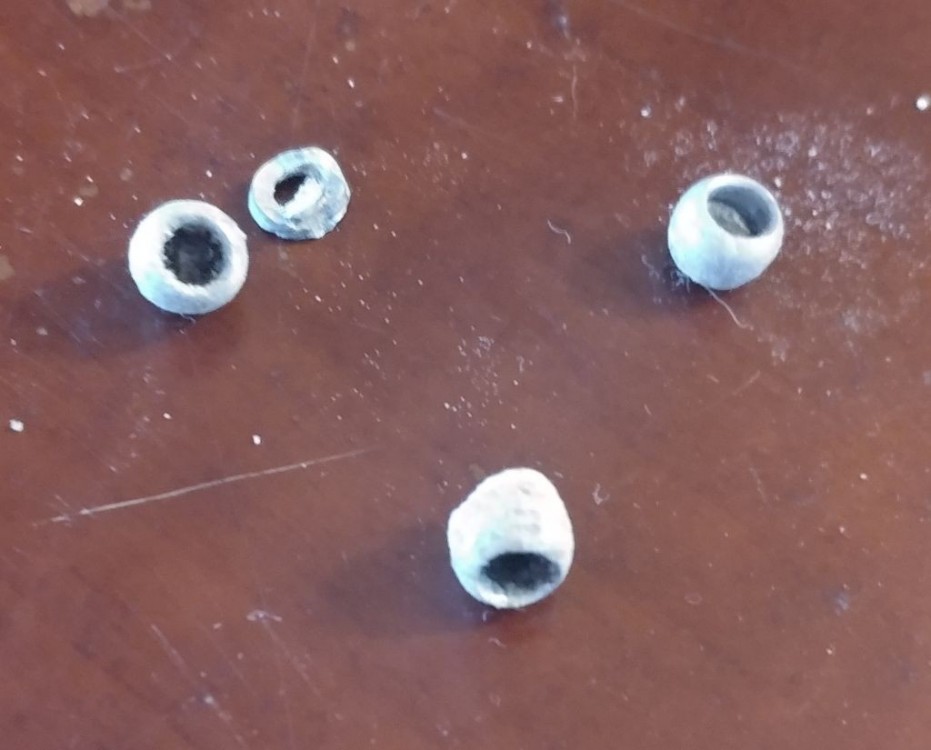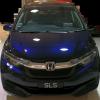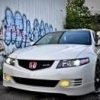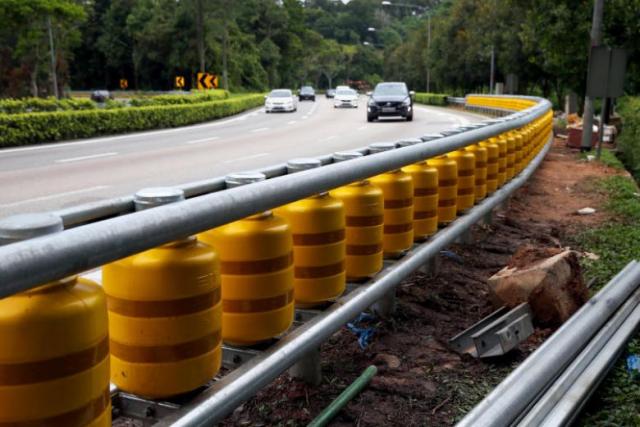Search the Community
Showing results for tags 'SAFETY'.
-
I had a small accident with this cheapo aluminum ladder. When I first step on it, the step broke off, 6 aluminum rivets are sheared off at the same time. Hurt my feet a little bit and marble floor suffered some chips. Luckily I am not at the top of the steps when it decide to break. I had earlier replaced the top step rivets with bolts and nuts, but the bottom step caught me off-guard. So if you have this kind of ladder, better have a second look, or maybe throw it away for own safety. Granted the ladder was quite old, I didn't use it much, the rivets may have corroded away. But I'd rather have a step ladder that doesn't do this.
- 71 replies
-
- 13
-

-

-

-
.png)
-
hi, i'm thinking of register myself for the upcoming fire safety manager (FSM), my objective is to have a skill and earn part time income if possible. may i ask if anyone can share with me on the prospective of a FSM. or i should just go for other better courses such as safety officer? i roughly google and seems not much good on being a FSM. thank you
- 67 replies
-
- fire safety manager
- fire
-
(and 2 more)
Tagged with:
-
Tech that detects falls to be offered to all HDB households after pilot at Queenstown Health District It is just one of many tools and systems being tested at the district, before deciding which can be implemented or installed in housing estates islandwide to improve residents’ quality of life. SINGAPORE: Technology that detects when a person has fallen at home and notify their family members will soon be offered to all Housing and Development Board (HDB) households. The pilot for the project was conducted for two months in Queenstown, the site of Singapore’s first Health District co-developed with the National University Health System (NUHS). It is just one of many tools and systems being tested at the district for potential use in housing estates to improve residents’ quality of life. HOW THE TECH WORKS Sensors are able to detect a resident's fall. If the resident does not get up within one minute, an alarm will sound to alert others nearby. Another, more advanced device uses Lidar, which scans for movements with light detection and ranging, and can sense and record the moment a person standing upright suddenly falls onto the ground. Those living alone can pre-set the device to send instant notifications to caregivers via a mobile app, along with the recording, when such incidents are detected. The systems were tested in the Health District from November 2022 to February 2023, and HDB aims to offer such technology to all its households across the nation later this year. “Through residents’ feedback, tech providers were able to refine the solutions … We are now stabilising the system and if all goes well, we will see how to progressively introduce this,” Dr Johnny Wong, Deputy CEO (Building) at HDB, told CNA’s Singapore Tonight on Tuesday (Feb 13). SAFETY MODIFICATIONS FOR SENIORS Apart from detection, HDB is also fine-tuning efforts to prevent falls. In Queenstown, close to 5,000 households have been modified to become safer, especially for seniors. This includes installing grab bars, non-slip tiles and ramps. Such built-in facilities will also be a staple at the district's upcoming assisted living apartments. The model could then be applied elsewhere across Singapore. In common areas, fitness and community amenities are also set to be installed so that residents can socialise and stay active. “We are piloting a social and wellness hub, which houses an active ageing centre. And we are piloting the very first ActiveSG gym within housing development, in collaboration with SportSG,” said Dr Chong Fook Loong, HDB’s group director of research and planning. “Along the way, we want to test every intervention – on what works, what doesn't work, and what we need to improve further, as part and parcel of this journey to create a healthy town.” SELECTING INTERVENTIONS Researchers from the National University of Singapore (NUS) source for, test, develop and evaluate such interventions for households in Queenstown. Professor Dean Ho, head of the biomedical engineering department at the NUS College of Design and Engineering, said that over 200 technologies were rigorously tested and evaluated before being narrowed down to the essentials. “We want to make sure we help understand what the residents are going through and deploy the best interventions that can help them,” he said. “We have to ensure that it's the right technology, it's cutting edge, it’s accessible and it’s validated. And ultimately, it can be truly adopted at scale.” One such tool, for example, helps a user to unscrew a bottle using one hand. It is designed to help those who have lost muscle strength, such as stroke survivors. Physiotherapy through gaming is another ongoing project, including a button-pressing console that tests a user’s reaction. It aims to provide light exercise for those with stiff shoulders. Other technologies that help residents monitor their health, such as vital signs and chronic conditions, are also being tested. “We have residents whose mobility is a challenge. We want to have digitally enabled solutions which perhaps can be done right from a mobile phone, that can monitor stress, respiratory rate. Then we can start to pinpoint residents that perhaps need some extra attention,” said Prof Ho. Such technologies will be trialled in the district in the coming months. SHARED CARE CONCEPT The district is also piloting a shared care team concept with social services agencies such as Lions Befrienders to provide social care for seniors. Volunteers visit residents with a listening ear and check on their well-being and needs. For one such resident, 82-year-old Yin Chee Keong, such visits are precious moments. “I feel lucky and I'm very touched. Because I do feel lonely at times. At night when I'm about to sleep, when I don't have someone to talk to,” he told CNA. Mr Yin gets weekly checkups on his vital signs and overall physical health at a Lions Befrienders community health post located right at his block. Such sites, helmed by NUHS healthcare teams, are typically set up in active ageing centres in neighbourhoods so that residents do not have to travel too far. Healthcare professionals visit once a week, while social workers based at the centres follow up with residents. Nurses and volunteers share updates on each resident’s physical, mental and social well-being as part of a personalised care plan to help them stay healthy. “Shared care is our way of working more closely with social partners to ensure that we consider a more holistic picture of their health needs,” said Ms Antoinette Goh, a nurse clinician at the NUHS Regional Health System. “For example, the care team decides that it will be good for a resident to start measuring blood pressure, but the resident doesn't know how to do it, or needs a bit more nudging. The social team can then remind them or provide some guidance on the ground.” Healthcare professionals and social workers said preventive care is the best way to ensure the seniors’ well-being. “When we do preventive work upfront … the going to hospitals, nursing costs, medical costs are going to be reduced once we go upstream and ensure that people stay as healthy as possible,” said Ms Karen Wee, executive director of Lions Befrienders. QUEENSTOWN HEALTH DISTRICT The Health District @ Queenstown is the nation’s first that supports residents’ well-being across their life stages through tools such as better design and community programmes. The initiative by HDB, NUHS, NUS and their partners aims to build a living environment that supports residents’ physical, social, and mental well-being, and help them lead more active and fulfilling lives. “We have four key objectives. One, we want to provide healthy living for all ages through good urban designs and use of technology. Second, to provide productive longevity, where people can continue to work, volunteer, co-create, and lifelong learning,” said Dr Wong. “Third, we want to promote intergenerational bonding. With good community support, one can live longer and have a better mental state. Lastly, we want all our residents to be able to live independently and age in place for as long as they can, in HDB towns.” https://www.channelnewsasia.com/singapore/queenstown-health-district-tech-seniors-detects-falls-health-hdb-4126056 getting ready for an ageing population.
-
Came across news that The Weather Channel debuted its new, mixed reality capabilities by showing what a tornado could do if it hit the studio. The demonstration has used mixed reality (MR), which is similar to augmented reality (AR) and virtual reality (VR) in that it creates virtual objects and then overlays them into the real world, but goes a step further and allows users to interact with them. Through MR the channel creates an incredibly realistic simulation of a tornado hitting the studio, with yellow ‘pop-ups’ appearing with facts and safety advice. For example, after a powerline crashes into the frame, Cantore tells viewers to stay at least 40 feet away from any live wires, saying that where he was standing would be too close to the pole if it was real. The ‘Tornado Hits The Weather Channel’ video ends with the anchor walking through the destruction after the studio is totally ripped apart. With sirens wailing, flickering video connection and sparks appearing to emerge from live wires, the entire experience - apart from Cantore himself - was meticulously created by the channel in partnership with The Future Group and powered by Frontier and Unreal Engine. The Weather Channel reckons the broadcast will “ignite a revolution of weather presentation” as part of a new era of real-time immersive storytelling. I personally find the safety advice extremely useful, as it give the viewer a clearer view of the potential hazards and associating risks in the real life situation, which shall have a more lasting effects in the viewers mind. Upon visiting this channel on youtube, found that they actually have several useful video, using similar VR technology, to remind drivers of the hazards of driving through different weather conditions. (and that is why this thread appears under the "General Car Discussion" section. And it is amazing that they actually started using VR technology some 3 years back... Can't wait for our MediaCorp to do the same for our otherwise boring news reporting and weather forecast. Imagine how it will look like to report ponding, hail storm, earthquake, etc. Our TP may also do the same to some of their educational video, to demonstrate, for example, the effect of road hogging and tailgating...
- 13 replies
-
- 10
-

-
It sadden me that these business owners are trying hard to avoid spending money on improving the safety of their workers, by painting a bad picture on the ban of using lorries to ferry workers. I am willing to pay more and accommodate the slight inconvenience for the safety of these foreign workers, who take up shitty jobs shunned by Singaporean. What about you? Singapore business groups warn of 'complexities', more traffic jams if firms banned from ferrying workers on back of lorries Source: https://www.channelnewsasia.com/singapore/complexities-traffic-jams-lorries-ferrying-workers-3669396 SINGAPORE: Any move to eliminate the transportation of workers on the backs of lorries for safety reasons involves "real, practical and operational complexities", a total of 25 business bodies said in a joint statement on Tuesday (Aug 1). The business chambers and associations, covering a wide range of industries, were responding to a call on Jul 24 by various advocacy groups and others for a timeline on banning the practice. That statement followed an accident in mid-July involving a lorry which appeared to be ferrying workers, with 26 men taken to three hospitals. This follows various accidents involving such lorries over the years. The statement from the business community, including the Association of Small and Medium Enterprises, released to the media, said: "In the process of transitioning to safer transportation modes for workers, it is essential to acknowledge that society must be ready to accept a change in the social compact." One consequence of transporting workers more safely would be more traffic on the roads and greater commuter congestion, it added. "The call for regulatory change to eliminate worker transport on lorries is a matter of great concern for us," added the bodies, which cover industries including construction, food manufacturing, marine and logistics. On Jul 24, more than 40 groups, businesses and individuals put out a joint statement calling for the Government to provide a timeline of measures working towards banning the transportation of workers on lorries. They included bodies advocating for foreign workers and other groups, a law firm, a music events firm, a mental health advocacy group and activists for a range of causes. Speaking to TODAY last month, Nee Soon Group Representation Constituency Member of Parliament Louis Ng said that he supports the Jul 24 statement, and had at the July sitting of Parliament also reiterated his call for such a timeline ahead of a ban on the transportation of workers on the backs of lorries. The business community's statement on Tuesday was addressed to Prime Minister Lee Hsien Loong, Acting Minister of Transport Chee Hong Tat and Senior Minister of State Amy Khor. The business groups said that the situation regarding safety in the transporting of workers had improved over the years but presents "real challenges that demand responsible and thoughtful engagement with various stakeholders". "Over the years, since 2011, we have taken significant strides in enhancing transportation safety for our workers, including the latest requirements under the Road Traffic Act, by closely collaborating with the Ministry of Transport and the Ministry of Home Affairs (the Traffic Police) and the relevant authorities. "As a business community, we are proud to share that many of our larger companies have successfully transitioned, either fully or partially, away from transporting workers on the back of lorries." The Road Traffic Act does not allow for passengers to be transported on the back of lorries, however it makes an exception for transporting workers employed by the vehicle's owner or if it is carrying someone injured in an emergency situation. The business groups' statement added that geographical constraints, limited infrastructure and economic realities that certain regions and industries face play a part in necessitating the widespread practice of transporting workers on lorries. "Regulatory changes have the potential to acutely affect industries that have historically relied on this practice, leading to potential delays in completing projects and risking the livelihoods of workers who depend on these industries for their employment." It also stated that the associations are "resolutely committed" to working closely with the Government, relevant authorities, labour unions, and safety experts to develop a "well-considered strategy" to ensure the safety of its workers. The statement ended by saying that the business groups appreciate the public's sense of urgency of addressing worker safety, and that they would "continue to navigate the complexities involved and actively seek innovative ways to enhance worker safety".
- 174 replies
-
- 11
-

-
Japanese city Nagoya bans walking on escalators NAGOYA, Japan – A Nagoya city ordinance requiring people to stand on escalators rather than walk on them went into effect on Sunday. In Nagoya, it is customary to stand still on the left side of the escalator and leave the right side free for people who want to walk up or down. The challenge now is how to let commuters know about the ordinance and enforce it to prevent accidents such as falls. Japan Today reported that in recent years, there have been many incidents of people losing their balance and knocking others over, as well as accidents involving commuters running up and down the escalators. The ordinance requires people to stand still on any escalator at train stations and other facilities in the city, regardless of whether they stand on the left or right. However, there are no penalties for breaking the rule. The Nagoya City government has been running TV commercials and putting up posters about the new ordinance at major train stations, reported Japan Today. Nagoya is not the first city to adopt this move. The Saitama prefectural government was the first in the country to enforce a similar ordinance in October 2021. A study found that at one point, enforcement decreased the percentage of people walking on escalators from 60 per cent to 38 per cent, but it has now returned to the pre-ordinance level. https://www.straitstimes.com/asia/east-asia/japanese-city-nagoya-bans-walking-on-escalators we should adopt too : - older stations like Orchard (NSL side), Dhoby Ghaut (NSL side) can't clear commuters from platform timely and safely during peak hours - some newer stations have very long escalators (eg Stadium, Jalan Besar) and its really not safe to walk on down riding escalator
-

'Brown shower' as Mazda gets covered in mud after accident in construction zone
Fadevfast posted a blog entry in MyAutoBlog
Mazda driver must have thought a giant took a s*** on his car. What happened? A Mazda driver was travelling along Marymount Lane when they no doubt s*** themselves after it looked like someone s*** on their car. As we can see in the video, a construction zone beside the road had some equipment malfunction, with a cable/tube snapping and unleashing a torrent of mud. The unlucky Mazda was able to get ahead by just a bit before the massive brown load splattered all over the road, leaving part of his windshield unobscured while the rear and roof of the car was covered in the filth. The brown shower did not end there however, as we see the mud continue to gush out of a tube before it finally ended. If there is a silver lining, maybe it’s that it could have smelled worse? Online chatter Some made joke of the free ‘mud bath’. Others were a little more concerned that this could happen, as if it was metal or concrete that fell instead there would be far more damage and possible casualties. ========= Be the first to get the latest road/ COE news and get first dibs on exclusive promos and giveaways in our Telegram SGCM Community. Join us today! -
So now stall operators need to pass SOC in order to conduct their business in Bukit Canberra Hawker Centre, since they will need to clear the counter top to get out of their stall in the even of fire? 😅 On a serious note, why place the fire extinguisher outside the stall if the stall personnel are not allowed to gain access to their stall from the front? Any safety expert can confirm if the design of the new hawker centre violated the fire safety requirements? Source: https://www.straitstimes.com/singapore/hawkers-worry-about-stall-design-after-fire-at-newly-opened-bukit-canberra-hawker-centre SINGAPORE - Foodcourt operator Canopy Hawkers Group will check if additional mitigation measures are needed after hawkers raised safety concerns following a fire at the newly opened Bukit Canberra Hawker Centre last Tuesday. One hawker said she had to climb over the fixed counter at the front of her stall to escape when an unattended stove at Long Xiang Ho Chiak Scissors Cut Curry Rice caught fire. Several hawkers also pointed out that fire extinguishers are placed beyond their reach on walls outside their stalls. Canopy Hawkers Group said the design layout of the stalls was made in consultation with a Qualified Person prior to deployment and is in compliance with the Fire Code, including on means of escape. A Qualified Person is a registered architect or a professional engineer. The single-storey hawker centre has 44 stalls, which are arranged in five hexagonal structures of eight to nine stalls each. Each stall has openings at the back leading into a common area shared by other stalls in the same ring. There is only a single common door allowing exit from the interior of each ring. Madam Christine Lock, 47, who runs a nasi lemak stall two stalls away from the one that caught fire, said she was with her husband when the fire broke out. She said she managed to scramble over the fixed counter, which is about 80cm high, but is worried about older and less mobile hawkers. “What if there’s a 70-year-old man in the stall, who may not be fit enough to climb over? What then?” Madam Lock said that to reach the fire extinguishers placed in front of the stalls, hawkers have to go out from the back of their stall, and then past the single common exit door. A hawker who wanted to be known only as Mr Lee said: “It’s quite ridiculous. The fire extinguisher is far away. If the back catches fire, then I have to jump out over the front counter.” “At least I can still get out,” said the 29-year-old, who runs Mexican-Indian fusion food stall Snack That Food Up. “But others may not be able to.” Another hawker, who wanted to be known only as Ming, said it takes her about a minute to walk from her front counter to the back exit, and round to her stall front. She said: “Sometimes, customers with a disability buy my food. Once, it was peak lunch hour and I had to carry someone’s plate to the table for him, but there were other people queueing too. “It wastes a lot of my time to walk one big round, since there isn’t an opening at the front counter.” She added that she had raised the issue with Canopy Hawkers Group several times. Darren (not his real name), who has been in the hawker business for more than 10 years and runs a stall at the hawker centre, said stallholders were informed of Canopy Hawkers Group’s “front counter clause” prior to the centre’s opening in December 2022. The Straits Times understands that stallholders had signed contracts that state that the stall front should allow for no entrance or exit of any person from the front of the stall. Tenants also have to place fire extinguishers within the stall. Canopy Hawkers Group, which has had experience running various foodcourts and coffee shops over the past 12 years, said the hawker centre, which is its first, was inspected for fire safety on Sept 13, 2022. An SCDF spokesman confirmed on Saturday that a Temporary Fire Permit, allowing the owner of the hawker centre to operate for 11 months before obtaining a Fire Safety Certificate, was issued to Bukit Canberra Hawker Centre on Sept 13. The permit is issued only if the fire safety work of a project has been satisfactorily completed with only very minor outstanding issues, he added. The certificate will be issued only after the completion of all fire safety works in the project.
- 44 replies
-
- 15
-

-

-

-
.png)
-
This is one airline safety-video that is not boring. Enjoy. http://www.youtube.com/embed/qOw44VFNk8Y?feature=player_embedded%22frameborder=%220%22allowfullscreen%3e%3c/iframe
-
While many auto manufacturers are gearing up for the next wave of automotive revolution, to produce more electric cars (including PHV - Plug-in Hybrid Vehicle) in-lieu of gasoline / diesel powered vehicles, are buyers and local government agencies (e.g. LTA, NEA, SCDF, BCA, etc.) ready for this big wave, and I am not merely referring to the basic infrastructure concerns, such as charging and servicing facilities. As the title suggested, this thread is more for taking an in-depth view on Safety and Environmental concerns, with regards to sales, usage, servicing and disposal of electric cars (mainly with the batteries). For a start, I will just be touching on the following, while more topics will be added in due course. I would welcome all to share their thoughts, and relevant stakeholders to take a leaf out of this topic. 1. Batteries At the moment, there are 2 main type of batteries commonly used in electric / hybrid vehicles: i) Nickel Metal Hydride (NiMH) ii) Lithium Ion (Li-ion), which uses different cathode materials such as Cobalt Dioxide, Nickel-cobalt-manganese, Nickel-cobalt-aluminum, Manganese oxide spinel & Iron phosphate. NiMH is most widely used in automotive industries as it is relatively safe in term of raw materials use, during charging / discharging, and emit less harmful substances during a fire, BUT have a lower power density (typically about half of what Li-ion can do), meaning it will either have a shorter traveling distance, or take up much more usable space (and weigh more) if to maintain a certain mileage. Li-ion, on the other hand, while enable electric cars to cover hundreds of miles per charge (without taking too much boot or cabin space), are much more hazardous, in the way that it can have a run-away reaction (resulting in fire / explosion) when exceeded a certain operating / storage temperature (~60 °C), emit toxic gases and substance during a fire, so more awareness and precaution is needed. Due to the characteristics of these batteries, special considerations have to be taken during storage, handling and usage, such as proper ventilation (to prevent gas built up - Oxygen, Hydrogen, etc.), minimized risk of dropping / knocking (Li-ion batteries maybe be rendered unsafe if dropped or subjected to sever impact), means of safety cut-off (to prevent over heating, triggering run away reaction) and such. 2. Building Infrastructure With reference to the above, special facilities (with precise temperature monitoring and control, enhanced ventilation system, specific fire-fighting system and equipment) maybe required for storing large amount of batteries. Mixed occupancy, i.e. storage and workshop facilities under the same roof, have to be carefully evaluated, to identify incompatible activities, e.g. workshop may produce excessive heat / spark (ignition source) thereby increasing the risk of fire / explosion. Also, is the existing fire compartmentation for building (fire code, regulations) sufficient to contain battery fire? Li-ion batteries for example will continue to burn once it hit the auto-ignition temperature, and the only control is to cool the surrounding to prevent fire from spreading to neighboring premises / units. In the case of an electric vehicle fire within say a basement car park, building structure must be able to withstand the period of time when the batteries continue to burn, ventilation system to be able to effectively remove toxic gases produced, such as CO, Ni & Li vapor, and means of cooling provided to contain the fire. 3. Fire Fighting and Emergency Response Interestingly, the most commonly used dry power extinguisher is NOT going to work on Li-ion batteries. Beside using cat D extinguisher - for metal fire (which is not commonly available anywhere), the next best option is water, mainly to cool down the surrounding and lower the battery temperature (to prevent explosion). And for fireman, the protocol is to attempt fighting the fire ONLY WITH proper respiratory protection - full breathing apparatus (prevent inhalation of toxic gases / vapors). If you thing this is no big difference from other fire fighting attempts, you are wrong. Fireman will also have to adopt the proper procedure. One important step is to cut off the power supply to the vehicle. Tesla has done pretty well in detailing the steps to fight fire on it vehicles (through publishing Emergency Response Guides for vehicles in their lineup). And hopefully our fireman from SCDF, when deployed to handle such electric car fire, will be fully aware of these steps... And here is a video taken recently, when a team of firefighters in Austria was responding to a Tesla Model S on fire. Firefighters with full BA set (breathing apparatus) Firefighters accessing to power disconnection switch And the responsible shall be shared by the owner of electric car too. They have to be fully aware of what to do when their vehicle catch fire, and keeping the fireman informed of the key information, e.g. location of power cut off switch, battery packs, etc. 4. Servicing and Disposal of Batteries The onus shall be mainly on the workshop and dealer performing the job (provided the owner send their electric cars to the right place for the job). Beside safety concerns with the high voltage of the electrical system, proper charging and discharging process must be observed during replacement. For example, if the positive and negative terminals of the battery come into contact, short circuit will arise, followed by fire. On environmental front, proper supply chain has to be established, to ensure that the used batteries will be disposed in accordance to local and international standards and guidelines. And during the treatment process, again, the toxic material and gases have to be properly taken care of. T.B.C.
- 205 replies
-
- 20
-

-
- electric car
- safety
-
(and 7 more)
Tagged with:
-
Globally well known for it's expensive cars , but in the safety department it is still far off from what is tested as standard. Looking into Passenger safety NCAP & ANCAP test are conducted on various cars , achieving 4 / 5 Stars had became a mile stone for car manufacturers to achieve. It is not certain how many car buyers do pay attention to this detail , or there are buyer just skim through. Focusing in Cat A vehicle most of the Cars sold are "suppose" to achieve 5 star rating , even a small size vehicle like Honda Jazz is able to achieve it . ANCAP = https://www.ancap.com.au/safety-ratings/5-star Euro NCAP =http://www.euroncap.com/ But here comes the bad news , in order to achieve 5 Stars most of the following criteria or features are install as standard : Dual frontal, side chest, and side head-protecting airbags (curtains) for the 1st and 2nd row are standard. Antilock brakes (ABS) electronic brake distribution (EBD) electronic stability control (ESC) hill launch assist and reversing collision avoidance are also standard* Advanced seat belt reminders are fitted to all seats.* * Clarification require Quite a number of favorite brands comes basic only with 2 airbags , some even without ESC. Paying so much for a car but still lacking in such detail is quite disappointing . We may have a world class ERP system , TOP notch COE system to control number vehicle on the road , Closing on new implementation on Carbon emission , but still a league way behind in terms of Car safety standards. Really hope LTA and even AD collaborate hand in hand to increase our car safety standard while maintaining a reasonable pricing across the board . Not just focusing on COE , car margin while neglecting on the safety features .
-
No spelling error as I am referring to those zombies affected by frequent usage of Zoom... Key risk factors: Zoning out while driving is a likely occurrence (driver focused on a smaller view) Cognitive distraction has also been cited in the study (frequent checking of mobile phone while driving) Deteriorating driving skills after working from home (less chance to drive and forgetting the basics) Visual fatigue with long hours behind screen (slower in detecting changes and reacting to it) In Singapore, there might be a 5th reasons: more irresponsible PAB and PMD users on the road resulted from surge in demand for food delivery services. So what's your take? “Zoom Zombies” Are the Driving Dead Video call fatigue may be a factor in surging highway fatalities If you’re one of the millions of Americans who have been working from home and spending hours a day in video meetings you might notice it can become difficult pulling your thoughts back together at the end of the day. And if you then have to climb behind the wheel that could prove deadly. A new study raises concerns about “Zoom Zombies,” motorists who can’t fully focus on the road ahead after a day of videoconferencing. This may be one of the reasons why in 2020 U.S. highway deaths posted their biggest year-over-year increase in nearly a century. “COVID-19 fundamentally changed the way we interact with our vehicles,” said David Timm, founder and CEO of Root Insurance, which raised concerns about Zoom Zombies in its annual Distracted Driving Awareness Survey. “As many abruptly shifted to a virtual environment, Americans’ reliance on technology dramatically increased along with their screen time, causing a majority of drivers to carry this distracted behavior into their vehicles.” Covid-19 and the distracted driving pandemic Distracted driving has become an increasingly serious problem as more and more motorists interact with smartphones and other technology while behind the wheel. Even before the COVID pandemic, the National Highway Traffic Safety Administration estimated that more than 10% of highway fatalities involved distracted driving. Preliminary analysis suggests that has gone up since last year’s lockdowns began. The Roots study found 64% of the U.S. motorists it surveyed acknowledging they check their phones while driving. That’s up 2% from last year, and 6% from the 2019 Distracted Driving Awareness Survey. Meanwhile, 53% of the respondents said they check their phones within the first 15 minutes behind the wheel — a 9% jump from 2019 — when they should be trying to shift focus to driving. Add the fact that drivers are downplaying the risks. The study found three in 10 drivers don’t see the risk of driving while using a mobile phone. That’s up from 24% just a year ago. But the study raised another concern: even when motorists aren’t texting or chatting on their phones, they still might not be paying full attention to the job of driving. Driving skills have atrophied That’s all the worse as we emerge from the pandemic, experts told TheDetroitBureau.com. During the last 12 months, most Americans have been driving less and even as roadways begin to look more crowded, “driving skills have atrophied for many people,” warns Sam Abuelsamid, principal auto analyst with Guidehouse Insights. “It’s become harder to drive safely because you’re going to forget some of the skills you learned over time,” added Abuelsamid. “It’s not as easy as just jumping back on a bike.” While he believes Zoom fatigue is “likely a contributor to the increase in highway fatalities,” how much it contributes is uncertain. What’s clear is that highway fatalities soared in 2020, even as motorists slashed the number of miles they drove. Record surge in fatalities Preliminary data indicated as many as 42,060 Americans were killed in motor vehicle crashes last year, the National Safety Council reported last month. That was an 8% increase from 2019. That surge occurred even though Americans drove a total of 2.83 trillion miles in 2020. That was a 13.2% decrease from the year before, marking the lowest level of driving by American motorists in two decades, reported the U.S. Federal Highway Authority. So, on a per mile basis, the death rate surged by 24% in 2020, the biggest year-over-year increase since 1924. Why does “Zooming” take so much out of people? It’s not like sitting around a table for an in-person meeting. Key visual cues are absent, such as body language, while others can overwhelm, according to psychologist Sharon Parker, director of the Centre for Transformative Work Design. They tend to be sharply focused, without the normal chit-chat and other interactions that come before — sometimes during — and after in-person meetings, Parker wrote. One result: participants come away struggling to interpret what actually happened rather than transferring attention to what comes next. And that may extend beyond the work day to when you’re behind the wheel and should be focusing on the road ahead.
- 12 replies
-
- 15
-

-
Walau eh.....catastrophic failure from an expensive $600 child seat. Hope no MCFers bought this seat. https://www.smh.com.au/national/expensive-children-s-car-seat-catastrophically-fails-test-ejects-dummy-20200303-p546hu.html
- 27 replies
-
- 1
-

-
- child seat
- safety
-
(and 1 more)
Tagged with:
-

Toyota delivers improved safety and greater sophistication
kobayashiGT posted a blog entry in MyAutoBlog
TOYOTA DELIVERS IMPROVED SAFETY AND GREATER SOPHISTICATION When it comes to designing and building cars, safety is of the utmost importance. No matter how beautiful, powerful and sophisticated a car is, if it cannot deliver absolute safety for its passengers, it's hard to build a compelling case for why customers would buy the car. However, if you think about it, many of the safety aspects of driving (in the past) is the responsibility of the driver. The car may have high strength steel and multiple airbags to protect occupants in the case of a collision, but the day to day safety depends very much on the driver. Think back to your Traffic Police test and all the little minutia that caused you to pick up demerit points - things like checking your blind spot every time you move off, looking out for pedestrians, making sure to signal before changing lanes and etc. Thankfully, modern technological advances have increasingly allowed carmakers to fit modern cars with a variety of driver aids. While the onus of safety is ultimately the driver's, these systems are there to assist the driver and reduce the chances of any accidents. In Toyota's case, these technologies come together to form the Toyota Safety Sense suite. 1. Pre-Collision System One of the main dangers when driving is getting into an accident. Sometimes, it could be you as the driver losing concentration. Other times, it could be a case of the vehicle in front of you suddenly jam braking. The Pre-Collision System uses an in-vehicle camera and a radar sensor to detect vehicles or pedestrians ahead of you. So, if you get too close to the car in front, the system will prompt you with audio and visual alerts to warn you to react. Certain cars are also equipped with Pedestrian Detection, which can react when an individual suddenly races in front of your car. When applying brakes, the system may apply additional force using Brake Assist, helping you to come to a stop more quickly. If you do not brake, the car may automatically apply the brakes to reduce speed and mitigate the chance of a collision. This is important, not just in protecting occupants in the car, but other road users as well. 2. Lane Departure Alert Another possible danger when driving is the vehicle veering to either side. This can be caused by fatigue, lack of attention or just poor road judgement. By using an in-vehicle camera to recognise vehicle lane markings, the Lane Departure Alert system will prompt you when you are veering out of your lane. This should alert you to steer your vehicle back into the centre of the lane. Additionally, Steering Assist is a reactive system that helps to prevent the car from drifting out of the lane. When it senses the car drifting into the next lane, the system will make small corrective inputs to steer the car back into the lane. With both Steering Assist and the Lane Departure Alert System switched on, the car assists in maintaining its position in the middle of the lane, allowing you to have a more relaxing drive. 3. Automatic High Beams A key element of safety is being able to see what's ahead of you. That of course requires the use of your head lights, and sometimes your high beam. When the road ahead if particularly dark, the system will automatically engage the high beam to allow you ample vision of the road ahead. Leaving your high beam always on, however, can potentially blind oncoming drivers. With the Automatic High Beams, an in-vehicle camera to help detect the headlights of oncoming vehicles and taillights of preceding vehicles, then automatically toggles between high and low beams accordingly. By toggling to the low beam, this ensures the oncoming driver won't be blinded, thus ensuring the safety of all parties on the road. 4. Dynamic Radar Cruise Control Sometimes, you just want the car to do the work for you. Accelerating and braking can be wearisome at times, and when cruising on the highway, it's sometimes nice to be able to let the car do it for you. With Dynamic Radar Cruise Control, the car can indeed take over some of these functions. DRCC uses vehicle-to-vehicle distance control, adjusting the car's speed to maintain a pre-set distance from the car in front of you. If the vehicle ahead is slowing down, DRCC will slow your car down without deactivating cruise control. When there's no longer a car ahead, the system will then accelerate back up to the set speed limit. This is of course especially useful when travelling on the highway. Instead of having to constantly accelerating and braking, you set a fixed distance and allow the car to automatically do that work for you. Of course, these systems cannot fully replace the driver. It doesn't mean that with these systems in place, you can then take your attention off the road. However, it does mean that as much as possible, the car will pre-empt you of any potential dangers, giving you additional time to react accordingly. Toyota models in Singapore offered with Toyota Safety Sense include the all new Corolla Altis, the Camry, the C-HR, the Harrier and the RAV4. The Supra also has its own specific range of safety systems called Toyota Supra Safety. The development of these Toyota Safety Sense technologies reflects the brand's commitment to creating 'Ever Better Cars'. -
anyone wears safety shoes for work ? i am looking at skechers ... but read a review that the front is abit small. another thing is it looks kinda heavy ... wonder if it really is ? i have been to a few skechers shops but it seems they do not have work shoes in their shops. i need something that provide extra cushioning and light like my skechers walking shoes, so hoping their workshoes are the same. i am wearing nitti now ... thye are good and lasting ... but thing is does not provide enough cushioning for my 90kg frame.
- 13 replies
-
Safety Moment is a tool, used by some companies, to maintain a high level of awareness towards Environmental, Health and Safety (EHS) issues, often in relation to the company operations. It involve the sharing of an EHS topic, usually by safety representative within the team, prior to the start of a work shift and/or meeting. To make it effective, such briefing / discussion are kept short and sharp (typically lasting just 1 - 3 minutes), with the aim of recognizing hazards and risks, reinforcing the importance of health and safety, and get everyone gearing towards a positive safety culture. I think it will be useful for MCF to have one, and let me start the ball rolling. Topic for today: Do not leave the engine of your vehicle running when it is stationary In accordance to section 21 of Environmental Protection and Management (Vehicular Emissions) Regulations, vehicle driver shall stop the engine, when the vehicle is stationary for reasons other than traffic conditions. Failing to do so shall constitute to an offence under the said regulations. While it might look like the authority (NEA) is finding fault with motorist, but in reality, leaving the engine on for an extended period have the following impact: 1) Polluting the environment (running engine emit harmful pollutants such as Hydrocarbons, Carbon Monoxide, Nitrogen Oxides, as well as Particulate Matter) 2) Create health issue for other road users and general public in the vicinity (prolong inhaling of pollutants stated above may have adverse health effect over an extended period of time) 3) Depleting natural resources (continuous burning of fuel) So please do our part, switch off the engine when waiting, to protect the environment and people around us.
- 85 replies
-
- 23
-

-
https://beltedsurvivors.nz/ 10 Car Crash survivors tell their stories about how their lives were saved by wearing their seat belts. They are pictured with simulated injuries from their accidents.
-
Today is the 1st time I am so involved with an traffic accident (don't worry, I am not hit or affected in anyway). I just crossed the road, walking away from the T-junction between Boon Lay Way and Jurong West Central 2, when I heard a loud bang behind me. Turning around and I saw a Toyota Altis mounting the kerb and moving onto the walkway next to it. A few meters away on the extreme right lane of the road, a Honda Fit Hybrid came to a abrupt stop against the kerb, with fume coming out from it bonnet. I immediately headed towards the Altis, which was closer to me, to check out the occupant in it. The driver stepped out of his car, filled with white smoke from the airbags activation, and immediately seated on the walkway, appearing dazy. I asked if he is ok, whether he need any assistance, etc. By then, many onlookers started to crowd around the car, taking photos and kaypoing. I asked if anyone has called the police and all kept quiet. So I dialed 999 and report the accident to the officer on the phone (I will share the details later), and request for ambulance to be dispatch (as one foreign worker pointed out to me that the other driver might need assistance). After asking the onlookers to clear away from the driver, I ran cross road to check out the occupant of the Fit. The driver limped out of his car (again, it was filled with white smoke from the airbag activation) and half laying against the kerb, complaining of chest pain and breathing difficulty. I told him to try breathing in harder and that he should lie down if he is feeling really uncomfortable. I called 999 again, to update them the conditions of both drivers, and was told ambulance is on the way (that is fast, as everything happened within just ~2 min). By then, 2 foreign workers came forward to offer bottled water to the driver, which I stopped them, for medical reasons, but the driver still proceed to take a sip of it, before I manage to snatch it away, explaining to him of the medical implication (of get choked and such).
- 12 replies
-
- 14
-

-
I hope this move can aid in having more enforcement check, nail down violators to the Fire Safety Act and Fire Code, and indirectly saving more lives. SCDF can appoint third parties to conduct checks under proposed changes to Fire Safety Act SINGAPORE: The Singapore Civil Defence Force (SCDF) can soon appoint authorised third parties to conduct routine fire safety enforcement checks and building inspections under proposed amendments to the Fire Safety Act introduced in Parliament on Monday (Jul 8). The move will enable SCDF to better utilise its resources and allow officers to focus on "more complex" enforcement inspections, said the Ministry of Home Affairs (MHA) in a press release. In order to regulate their operations, these third parties will be required to don body-worn cameras during inspections. They will also be subject to routine checks by the SCDF. Under the new amendments, the SCDF will also be able to compel building owners to install critical fire safety upgrades, such as fire alarm systems and fire hose reels, if they are deemed necessary for public safety. The SCDF regularly reviews the fire code, which specifies fire safety standards for buildings. However, changes to the code only apply to new buildings, and to existing ones that undergo addition and alteration works. There are currently no measures to mandate owners of existing buildings which have not undergone any addition and alteration works to install the latest fire safety measures. "In exercising this mandate, SCDF will adopt a judicious, risk-based approach in identifying buildings for fire safety upgrades," said MHA. "For example, relevant considerations include the buildings’ fire risk profile, based on factors such as building age, purpose and the profile of its occupants." STRICTER REGULATIONS There will also be harsher penalties for five offences under the Fire Safety Act. These offences mainly involve the unauthorised change of use of premises which could cause the existing fire safety measures to become inadequate, as well as instances where industry professionals such as registered inspectors do not responsibly supervise and certify fire safety works. The penalty for the unauthorised change of use of premises will be raised from a maximum fine of S$10,000 to S$200,000 and/or up to two years’ jail. The penalty for the failure of an appointed Qualified Person to supervise fire safety works will also be raised from a maximum fine of S$10,000 and six months’ jail, to a maximum fine of S$200,000 and/or up to two years’ jail. In addition, SCDF’s enforcement and investigative powers will be enhanced to hold responsible those who flout fire safety rules. Currently, when dealing with fire hazards, SCDF must first issue a Fire Hazard Abatement Notice and can only take action against the errant parties if they fail to comply with the Notice. But as some fire hazards may pose "serious and significant" fire safety risks, SCDF will have the option to immediately prosecute culpable parties. Its officers will also be able to investigate suspects for fire safety violations, and take statements when there is reasonable suspicion of an offence. The Bill will also allow SCDF officers to enter any premises that may have evidence of fire safety offences. Said MHA: "While the number of fire incidents in Singapore has remained stable and our fire fatality rates are low, we must periodically review and update our fire safety regulations, so that they continue to remain robust and relevant, and we can effectively respond to new and evolving fire safety risks and challenges."
- 14 replies
-
- 8
-

-
- fire safety
- fire safety act
-
(and 7 more)
Tagged with:
-
I came across this article about Ikea cabinets killing children in the US. Ikea USA issued a recall on it some time ago (now "relaunching" that recall). The recall for similar cabinets was extended to China but Ikea Singapore still claims it is safe to use in Singapore. Some questions come to mind: 1. How can the same item be unsafe in USA and China but safe in Singapore? Our children are made tougher than ang mo and PRC children? 2. Ikea Singapore says there are no incidents in Singapore except one from 10 years ago. Are they waiting for something to happen before they act? 3. People have been saying that consumer safety is lacking in China. Guess what, Singapore is worse! (at least in this case). Disclosure: have a toddler and ikea stuff at home
- 16 replies
-
- 1
-

-
I advocate Taxi/PHV should be regulated to have equipped with a minimum in-car safety standard. To me, it is their very basic social responsibility to make sure the car is as safe as possible. As public transport, shouldn't they have responsibility to the safety for their passengers? Everytime a taxi/PHV involved in an accident, the driver is the only one responsible. Shouldn't the Taxi/PHV rental companies have responsibility? Full spec SRS is the most basic one. Why they are not equipped with full SRS specs? Are they really not affordable with Singapore standard of living? Most passengers sit at the back seat. Curtain airbags could have saved life and avoid serious injuries, including the Commonwealth Avenue West accident at 19 Apr 2018, should the taxi was equipped with curtain airbag. (To the victim family, Sorry to bring up this painful lost. My thought is with the young lady. My intention is to do something to prevent similar incident in future.)
-
Hi was wondering how to deal with motorcyclist who squeezed behind when vehicle reversing into lot suddenly? Before reversing I checked there was no vehicle/ motorcycle around. Then with hazard light on was reversing and this motorcycle suddenly appeared and squeeze in the gap between the lot and other stationary cars parked beside. Good thing he managed to do it skillfully and no one was hurt I horned to him and he showed middle finger.
-
Question... Does our local Honda authorised dealer sell Honda cars with Honda Sensing?? I've read and watched so much about it on the internet, but some member here said don't compare with other countries.
- 25 replies
-
- 1
-

-
Sharing nice video of safety features of Japan brands.. https://www.youtube.com/watch?v=-SIch-88wtI&index=60&t=29s&list=WL
-
SINGAPORE - A stretch of yellow-barreled rails over 20m in length was recently installed along the road shoulder of the slip road leading to the start of the Bukit Timah Expressway (BKE) towards Woodlands. The rails resemble the rolling barrier system, a road safety feature, seen in several countries including Malaysia, Australia and the United States. Singapore Road Safety Council chairman Bernard Tay told The Straits Times the new guardrails are better at absorbing the impact from a vehicle crash. "It behaves like a shock absorber," said Mr Tay. "Unlike conventional metal barriers, this system absorbs the (crash) impact and deflects it, making it safer for the driver and reduces the likelihood of a vehicle crashing through the barrier." ST understands the system is new here. It is being tested by the Land Transport Authority which will soon be giving details about it. A close inspection of the "barrels" with reflective markers reveal they were manufactured by a South Korean company called Evolution in Traffic Innovation (ETI) https://www.youtube.com/watch?v=WXVUAR5kjOA So how does the rolling barrier system work? When a vehicle hits the guardrail, the rotating barrels convert the shockwaves to rotational energy. The railway-type rails in the system also absorb the shockwaves while simultaneously guiding the accident vehicle away from the impact zone. In theory, this helps prevent unwanted rear-end collisions. The size and speed of a vehicle may affect the performance of the safety barrier. https://www.youtube.com/watch?v=KdPmlriLSkQ The latest road safety technology, however, does not come cheap. The cost of installing 1m of the Roller System is reported to range between US$300 (S$414) and US$400 (S$553). But the cost of maintaining the guardrails apparently will be low as only damaged parts need to be replaced following a crash. In Mr Tay's view, the price is a small one to pay. "It's a good thing that LTA is making an effort to put in new innovation," he said. "Hopefully it (the rolling barrier system) saves more lives and reduces the injury to motorists."














